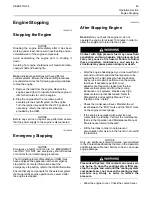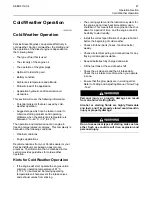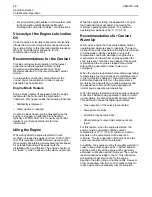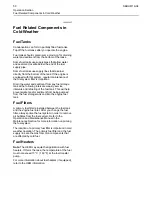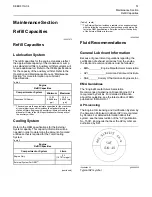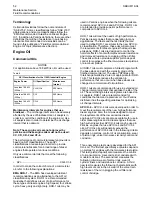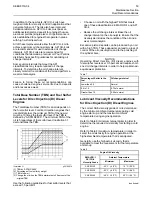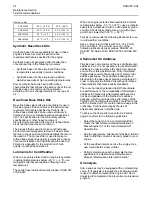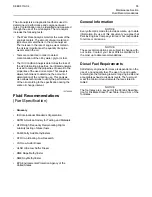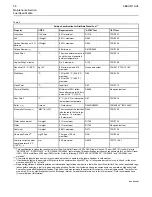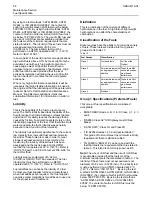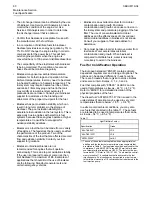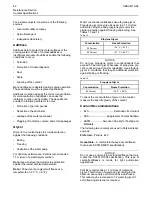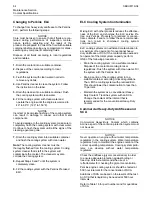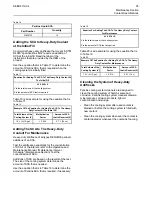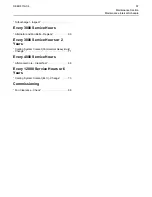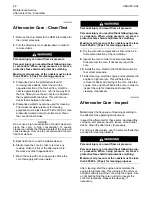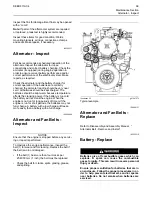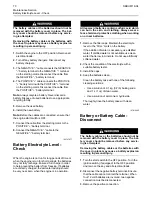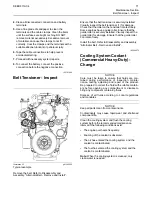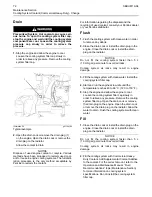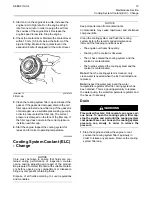
Group 2 Specifications (Permissible
Fuels)
This group of fuel specifications is considered
acceptable, but only with an appropriate fuel additive,
but these fuels MAY reduce the engine life and
performance.
•
“JP7 (MIL-T-38219)”
• “NATO F63”
• JP8
• JP5
• “Jet A1 (ASTM D1655)”
• “Jet A (ASTM D1655)”
• “NATO F34 ”
Note:
These fuels are only acceptable provided that
these fuels are used with an appropriate fuel additive.
These fuels must meet the requirements that are
stated in table 9 . Fuel samples should be analyzed
for the compliance. These fuels MUST NOT exceed
lubricity wear scar diameter of 0.52 mm
(0.0205 inch). The fuel lubricity test must be
performed on a HFRR, operated at 60 °C (140 °F).
Refer to “ISO 12156-1 ”. Fuels must have minimum
viscosity of 1.4 centistokes that is delivered to the
fuel injection pump. Fuel cooling may be required in
order to maintain minimum viscosity of 1.4
centistokes that is delivered to the fuel injection
pump.
Group 3 Specifications (Permissible
Fuels)
This group of fuel specification must be used only
with the appropriate fuel additive. This fuel WILL
reduce engine life and performance.
“JIS 2203#1 and #2 Toyu”
Note:
These fuels are only acceptable provided that
these fuels are used with an appropriate fuel additive.
These fuels must meet the requirements that are
stated in table 9 . Fuel samples should be analyzed
for the compliance. These fuels MUST NOT exceed
lubricity wear scar diameter of 0.52 mm
(0.0205 inch). The fuel lubricity test must be
performed on a HFRR, operated at 60 °C (140 °F).
Refer to “ISO 12156-1 ”. Fuels must have minimum
viscosity of 1.4 centistokes that is delivered to the
fuel injection pump. Fuel cooling may be required in
order to maintain minimum viscosity of 1.4
centistokes that is delivered to the fuel injection
pump.
Group 4 Biodiesel
Biodiesel is a fuel that can be defined as mono-alkyl
esters of fatty acids. Biodiesel is a fuel that can be
made from a variety of feedstock. The most
commonly available biodiesel in europe is Rape
Methyl Ester (REM). This biodiesel is derived from
rapeseed oil. Soy Methyl Ester (SME) is the most
common biodiesel in the United States. This
biodiesel is derived from soybean oil. Soybean oil or
rapeseed oil are the primary feedstocks. These fuels
are together known as Fatty Acid Methyl Esters
(FAME).
Raw pressed vegetable oils are NOT acceptable for
use as a fuel in any concentration in compression
engines. Without esterification, these oils gel in the
crankcase and the fuel tank. These fuels may not be
compatible with many of the elastomers that are used
in engines that are manufactured today. In original
forms, these oils are not suitable for use as a fuel in
compression engines. Alternate base stocks for
biodiesel may include animal tallow, waste cooking
oils, or a variety of other feedstocks. In order to use
any of the products that are listed as fuel, the oil must
be esterified.
Note:
Engines that are manufactured by Perkins are
certified by use of the prescribed Environmental
Protection Agency (EPA) and European Certification
fuels. Perkins does not certify engines on any other
fuel. The user of the engine has the responsibility of
using the correct fuel that is recommended by the
manufacturer and allowed by the EPA and other
appropriate regulatory agencies.
Recommendation for the use of biodiesel
Use of FAME fuels is permissible. However, the
following conditions apply:
• The FAME fuel must comply with “EN14214”.
• A maximum of 5% mixture of FAME can be used
in mineral oil diesel fuel, provided that the fuel
complies with the fuel specification that is listed in
table 9 . This blend is commonly known as B5. No
mixture above 5% is acceptable. Concentrations
above 5% will lead to reduced product service life
and potential failure of the fuel injection
equipment.
Note:
When biodiesel, or any blend of biodiesel is
used, the user has the responsibility for obtaining the
proper local exemptions, regional exemptions, and/or
national exemptions that are required for the use of
biodiesel in any Perkins engine that is regulated by
emissions standards. Biodiesel that meets EN 14214
is acceptable. The biodiesel must be blended with an
acceptable distillate diesel fuel at the maximum
stated percentages. However, the following
operational recommendations must be followed:
SEBU8119-04
59

